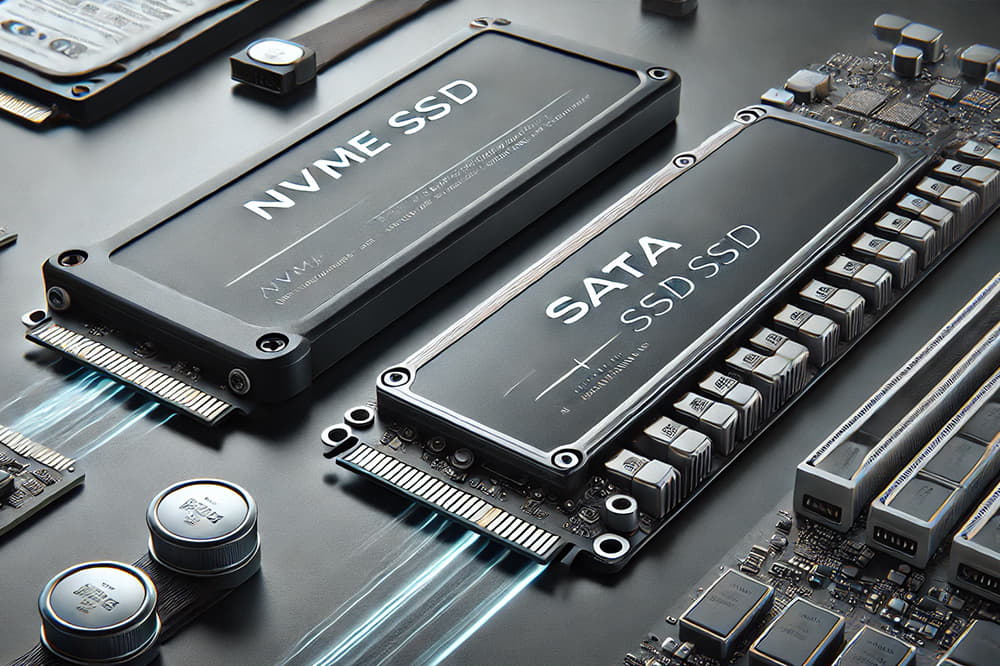Introduction to SSDs
In recent years, solid state drives (SSDs) have revolutionized computer storage, offering significant improvements over traditional hard drives (HDDs). However, within the world of SSDs, there are different types, the most common being SATA SSDs and NVMe SSDs. In this article, we will explore the advantages of using NVMe SSDs vs SATA SSDs, highlighting their differences and benefits.
Basic differences between NVMe and SATA
SATA (Serial ATA) and NVMe (Non-Volatile Memory Express) are communication interfaces used by SSDs to transfer data. The main difference lies in the speed and efficiency of each interface. SATA is an older technology and while it offers significant improvements over HDDs, its speeds are limited by the interface. On the other hand, NVMe is specifically designed to take full advantage of the speeds and capabilities of modern SSDs, using the PCIe (Peripheral Component Interconnect Express) bus to offer much higher performance.
Speed and performance
One of the most important aspects when considering an SSD is its speed and performance, where NVMe SSDs clearly stand out over SATA SSDs.
Reading and writing
NVMe SSDs offer significantly faster read and write speeds than SATA SSDs. While a typical SATA SSD can reach speeds of up to 550 MB/s, an NVMe SSD can easily exceed 3,500 MB/s, and some high-end models can reach 7,000 MB/s. This results in faster loading times for operating systems, applications and games, as well as more efficient file transfer.
Latency and access time
In addition to read and write speeds, latency and access time are crucial factors for the overall performance of an SSD. NVMe SSDs have significantly lower latency compared to SATA SSDs. This means that data can be accessed more quickly, which improves system responsiveness and reduces wait times on various tasks.
Energy efficiency
Power efficiency is another important factor to consider when choosing between an NVMe SSD and a SATA SSD, especially for portable devices like laptops and ultrabooks.
Power consumption in NVMe
NVMe SSDs, thanks to their more modern and efficient design, usually have optimized power consumption. Although they may consume more power at high peak loads due to their higher transfer speeds, their efficiency in terms of performance per watt is superior, making them more suitable for intensive applications without compromising too much on battery life.
Comparison with SATA
In comparison, SATA SSDs generally have more consistent power consumption but are less efficient in terms of performance per watt. For users looking to maximize battery life and overall performance, NVMe SSDs represent a more balanced and energy-efficient option.
Costs and benefits
When evaluating the adoption of NVMe SSDs versus SATA SSDs, it is essential to consider both the initial costs and long-term benefits.
Cost analysis
Traditionally, NVMe SSDs have been more expensive than SATA SSDs, but this price difference has narrowed over time. Although high-end NVMe SSDs are still more expensive, there are affordable options on the market that offer noticeably better performance than SATA SSDs for a reasonable price difference.
Long-term benefits
Investing in an NVMe SSD may seem more expensive initially, but the long-term benefits far outweigh the investment. Faster loading times, greater system responsiveness, and better energy efficiency can translate into improved productivity and a more satisfying user experience. Additionally, with the trend toward increasingly demanding software and games, an NVMe SSD offers better future-proofing.
Installation and compatibility
When upgrading to an NVMe SSD, it’s important to consider the system requirements and installation steps required.
System Requirements
Not all systems support NVMe SSDs. It is necessary that the motherboard has an M.2 slot compatible with NVMe and that the BIOS supports this technology. Most modern computers, especially those designed for gaming or professional use, meet these requirements, but it is important to check compatibility before purchasing.
Installation steps
Installing an NVMe SSD may seem complicated, but with the right steps, it’s a fairly simple process:
- Turn off your computer and disconnect it from the power.
- Open the case and locate the M.2 slot on the motherboard.
- Insert the NVMe SSD into the M.2 slot at a 30-degree angle and gently push it until it clicks into place.
- Secure the NVMe SSD with a screw to ensure it is secure.
- Close the case, connect your PC and turn it on.
- In the BIOS, make sure the NVMe SSD is detected and set it as the boot disk if necessary.
Conclusion
Comparing the advantages of NVMe SSDs versus SATA SSDs, it is clear that NVMe offers significant improvements in speed, performance, and power efficiency. Although the initial cost may be higher, the long-term benefits in terms of productivity and preparedness for future technological demands make NVMe SSDs a worthwhile investment. By considering these factors and ensuring the compatibility of your system, users can enjoy a significantly improved computing experience.
To explore the best SSD storage solutions, visit the Hard Drives at Ibertronica section. , where you will find a wide range of options.







